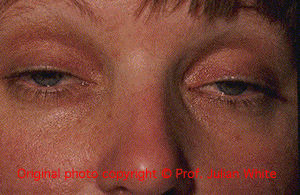
These act at the skeletal neuromuscular junction (NMJ), either pre or post-synaptically, causing progressive paralysis of voluntary and respiratory muscle. Because the venom must first reach the NMJ and then fix to target tissues, the first effects of these toxins are not seen in less than 1 hour after the bite and usually the earliest signs take 2-4 hours or more to develop. Complete paralysis, which is not common, even in untreated cases, may take from 3 to greater than 18 hours to develop, but breathing difficulty due to paralysis of the tongue and pharynx may develop much earlier than full respiratory paralysis and require intubation and ventilation.
 |
Bilateral ptosis |
Key early signs include; ptosis, partial ophthalmoplegia with diplopia, dysarthria and loss of facial expression. Ptosis alone may be seen with severe envenoming by mulga snakes.
Key laboratory tests; there are none which are diagnostic but pulse oximetry may be helpful in documenting deteriorating respiratory function.
Key species; tiger snakes, taipans, death adders, rough scaled snake, copperheads, and only rarely brown snakes.
Value of antivenom treatment: for post-synaptic only paralysis ( eg. Death adders), even late antivenom may reverse paralysis, but established, severe pre-synaptic paralysis (eg. tiger snakes, taipans, rough-scaled snake) will not be reversed by antivenom.